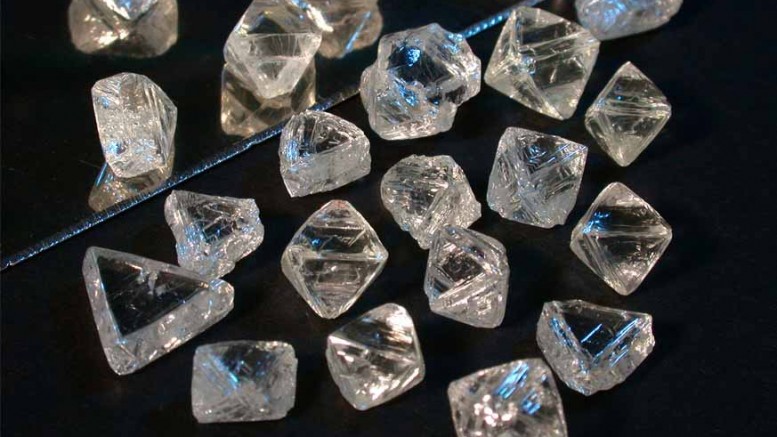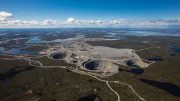After being virtually shut down since March, the diamond market has slowly come back to life. This fall, De Beers, the world’s largest diamond producer by value, has reported a growing momentum in sales. Several small producers also reported their first regular diamond tenders in Antwerp in September, and mines such as Renard in Quebec and Mothae in Lesotho that have been on care and maintenance since March have restarted.
Anecdotal evidence suggests that diamond prices have rebounded from lows earlier in the year, says Edward Sterk, director of mining research at BMO Capital Markets. “In terms of pricing, and bear in mind, this is all anecdotal because we don’t have any real data from the companies with regards to the September quarter, I’m hearing that prices are about 5% below where they were in February. So they’re back to pre-Covid levels or close to.”
By some estimates, prices at the peak of the pandemic were down by 20-30%, but in a very low volume market.
Despite the price bounce, the market is still far from healthy. Sterck cautions that De Beers and Alrosa, the largest producers, have amassed large inventories of rough since the pandemic began. How they handle those inventories will have big implications for the survival of smaller producers.
“The current strength in rough diamond pricing is probably sustainable only so long as we see continued discipline from De Beers and Alrosa in terms of the pace at which they liquidate the excess inventory they’re accumulated during the last six months or so,” he says.
If they decide to be “kind” and sell their inventories back into the market fairly slowly, it would be supportive of the market in general. “I’m not sure that one can necessarily guarantee that that will be the case,” Sterck says. “They’ve got their own shareholders to worry about. Their behaviour probably not going to be predicated on trying to support everyone else.”
Sterck puts pre-Covid rough diamond demand at around 130 million carats per year and 2020 production capacity at about 100 million carats, after cuts to production. “In the medium to long term, it’s possible we could see better prices after that inventory is depleted. The first question is, how long will that take? The second question is, is it fair to assume that consumer demand for diamond jewelry will return to pre-Covid-19 levels? That, I think, is an open question at the moment.”
In its most recent sight, De Beers reported revenues of US$467 million, up from US$334 million in its seventh sight, and US$116 million from the sale before. In a research note, Sterck said the numbers indicate the diamond pipeline is in restocking mode for the upcoming holiday season, but since the company doesn’t release volume or pricing information, pricing momentum is difficult to gauge.
Renard restart
While the strength of the market may still be uncertain, it’s been encouraging enough for Stornoway Diamond to reopen its Renard mine, in Quebec. The company was delisted and restructured last year, after entering creditor protection, and then acquired by a group of its creditors, including 35% owner Osisko Gold Royalties (TSX: OR).
The mine had been on care and maintenance since late March, when the Quebec government ordered the suspension of mining operations. While mines were allowed to reopen in April, Stornoway chose to keep the mine on care and maintenance, citing the depressed diamond market.
The new owners decided to reopen in September based on both encouraging signs from the market and confidence in its restart plan for Renard, says Benoit Brunet, Osisko’s vice-president, business strategy.
“We had worked during the summer at outlining a pretty comprehensive detailed plan of what a restart scenario could look like,” Brunet says. “Once we had outlined that, and cross-referenced that scenario with the market dynamics at that time, we felt that it was a good time to give it a shot. It was the combination of both the market and confidence in the restart plan that allowed us to restart the operation in September.”
The restart plan involves implementing $30 million in cost-cutting measures over 16 months, including some worker layoffs. At the same time, the partners put in place a $30-million senior secured working capital facility in case of cash crunches the operation may experience over the next couple of years.
Alongside the operational restart, Stornoway held its first tender since the start of the pandemic in September, selling more than half of its inventory of 332,000 carats. Brunet wouldn’t comment on pricing, but said the partners were pleased with the sale.
“In September, there were a bunch of people going back to the market. A lot of the normal tendering mines had sales, and I would say that the attendance was pretty much in line with what we would have expected and what we saw pre-Covid.”
Alternative sales processes
While trading in Antwerp resumed in May, the business is still limited by travel restrictions, says Sterck.
“One of the restrictions – and this hasn’t really changed – is the international travel limitations, which just make it very difficult, almost impossible, for diamantaires from India in particular to travel to Antwerp or Botswana to go and view goods before purchasing.”
That means that alternative sales processes instituted by many of the smaller producers, including Lucara Diamond (TSX: LUC), Mountain Province Diamond (TSX: MPVD), and, most recently, Lucapa Diamond (ASX: LOM), are likely to stay in place.
The arrangements have allowed the miners to generate revenue during the pandemic, and even to get a slice of the revenue from the polished outcome of their production.
Lucara’s deal with the HB Group is for diamonds larger than 10.8 carats and will last through 2020, while Mountain Province’s $100-million sales arrangement is with Dunebridge Worldwide, a company controlled by its largest shareholder, and Lucapa’s involves direct offtake agreements with diamantaires.
“The sales measures are all very different, and I think it’s pretty hard at this point to really judge them,” Sterck says. “I think the key thing for all of them is, whatever alternative sales process they’ve put in place, that’s allowed them to keep the wolves from the door.”
As to whether the pandemic has forced the diamond sector, which has been slow to modernize the way diamonds are bought and sold, to innovate, Sterck says that’s still to come.
“I think the sellers have been keen to innovate for a while, but it’s about persuading the customer base [diamantaires] to have comfort in the alternative sales and purchasing methods,” he says. “I hesitate to say that right now we’re seeing innovation that will be transformative going forward. But the pandemic probably will precipitate that.”




Be the first to comment on "Diamond market shows signs of revival"